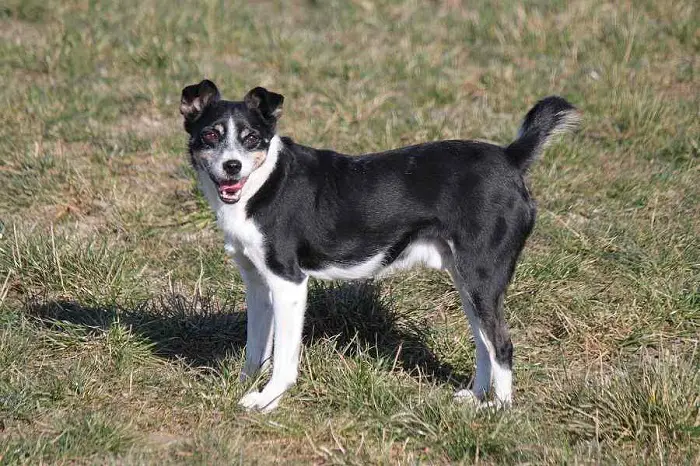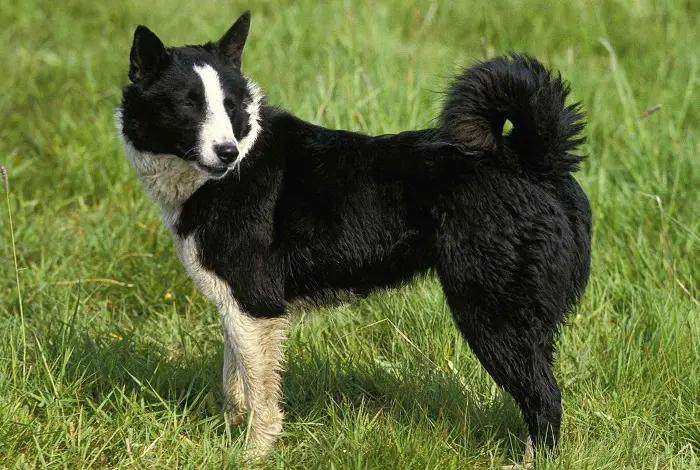The Karelian Bear Dog is a cautious, tenacious dog breed originating in Finland. They are not considered a famous family companion simply because it is bred to be a naturally aggressive and stealthy hunter. However, the dogs are very loyal to their human families.
The Karelian Bear Dog is a very protective watchdog. The dog breed is Karjalankarhukoira, Karelischer Barenhund, or Karelsk Bjornhund. This article gives a clear idea and helpful information that is very interesting for a Karelian Bear dog lover. So, stick with us and keep reading!
History and Origin of Karelian Bear Dog
The Karelian Bear Dog is believed to be descended from indigenous northern European dogs and was developed to hunt bears and elk, working alone rather than in packs. It is closely related to the Russo-European Laika.
It is bred to harass the prey. It was nearly extinct after World War II, but the Finnish Kennel Club worked to restore the breed. The Karelian Bear Dog has recently been used in programs to deter bears from entering developed suburbs.
Physical Description of Karelischer Barenhund
The Karelian Bear Dog is medium-large and sturdy, slightly longer than tall. It has a large, triangular-shaped head, and its muzzle is short and thick. It has a large black nose and small brown eyes. The prick ears are medium-sized and triangular.
The tail is naturally bob or long and carried loosely over the back. It is double-coated with short, medium-length, straight hair that is longest at the neck, back, and rump. The coat is black and white.
Height, weight, Lifespan, and Litter Size of Karelian Bear Dog
- The average height of the Karelian Bear Dog is about 19.25 to 23.5 inches (50 to 60 cm).
- The average body weight of the dog breed is about 44 to 50 pounds (20–25 kg).
- The usual life expectancy of the dog is about 10 to 12 years
- The litter size is about 4 to 8 puppies
Temperament or Personality of Karelischer Barenhund
It is often aggressive with other dogs and is not typically considered a suitable house pet.
Best Ownership: Karelian Bear Dog
The Karelian requires an experienced, active owner in a rural home.
Special Needs of Karelischer Barenhund
The Karelian Dog, also known as the Karelischer Bärenhund, is a Finnish breed of dog known for its hunting abilities, particularly in tracking and handling large game, including bears. Here are some special needs and considerations for caring for a Karelian Bear Dog:
- Exercise: Karelian Bear Dogs are highly energetic and require regular physical exercise to stay happy and healthy. They have a strong hunting drive and love to explore their surroundings. Providing them with daily opportunities for physical exercise and mental stimulation is essential.
- Secure Fencing: Due to their strong hunting instincts, Karelian Bear Dogs have a tendency to roam and may chase after small animals. It’s essential to have a secure, well-fenced yard to prevent them from escaping and potentially getting into trouble.
- Socialization: Proper socialization is crucial for Karelian Bear Dogs. Introduce them to various people, animals, and environments early to help them develop good social skills. Early socialization can help prevent potential aggression or fearfulness.
- Training and Mental Stimulation: Karelian Bear Dogs are intelligent and independent thinkers. They require consistent and firm training methods that emphasize positive reinforcement. Engage them in obedience training, mental games, and interactive toys to keep them mentally challenged and prevent boredom.
- Hunting Instincts: It’s essential to understand that Karelian Bear Dogs have strong hunting instincts deeply ingrained in their nature. They may not be comfortable living with small pets, such as cats or rabbits, as they might view them as prey. Supervision is necessary when introducing them to other animals.
- Regular Grooming: Karelian Bear Dogs have a dense double coat that needs regular brushing to prevent matting and to keep their coat healthy. They typically shed heavily twice a year, during which more frequent brushing is necessary to manage the shedding.
- Health Care: Like any dog, Karelian Bear Dogs require routine veterinary care, including vaccinations, parasite prevention, and regular check-ups. Be aware of breed-specific health issues, such as hip dysplasia and certain eye conditions, and work with a reputable breeder to minimize the risks.
- Mental Well-being: Karelian Bear Dogs are known for their loyalty and bond with their human family. They thrive on companionship and should be supported for extended periods. Lack of social interaction can lead to separation anxiety and destructive behavior.
Remember that each Karelian bear dog is different and may have specific needs or temperaments that vary from the general breed characteristics. A loving, structured environment with proper training, exercise, and socialization is vital to raising a well-rounded and happy Karelian Bear Dog.
Health Concerns of Karelian Bear Dog
Karelian bear dogs are generally considered healthy with no specific breed-related health concerns. However, like all dogs, they can be prone to specific health issues. Here are some health concerns that can affect Karelian bear dogs:
- Hip and elbow dysplasia is common in many dog breeds, including Karelian bear dogs. It is a hereditary condition where the hip joint does not develop adequately, leading to joint instability and potential arthritis. Regular exercise, maintaining a healthy weight, and breeding from health-tested parents can help reduce the risk of hip dysplasia.
- Progressive Retinal Atrophy (PRA): PRA is an inherited eye disease that leads to progressive vision loss and, in severe cases, blindness. Regular eye examinations by a veterinary ophthalmologist can help detect PRA early, allowing for appropriate management and care.
- Hypothyroidism: This disease occurs when the thyroid gland is not capable of producing enough hormones, leading to a range of symptoms such as reluctance, weight gain, and skin issues. If you notice any signs of thyroid diseases, such as changes, lack of appetite, or energy levels, consult a veterinarian for diagnosis and treatment.
- Allergies: Like many other dog breeds, Karelian Bear Dogs can develop allergies to environmental triggers (such as pollen, dust mites, or certain foods) or specific ingredients in their diet. Allergies can manifest as skin irritations, itching, hair loss, and gastrointestinal issues. Identifying and avoiding allergens and appropriate veterinary care can help manage these allergies.
- Gastric Dilatation-Volvulus (GDV): Also known as bloat, GDV is a severe and potentially life-threatening disease affecting deep-chested breeds, including Karelian Bear Dogs. It occurs when the dog’s stomach fills with gas and rotates, leading to a blocked blood supply and possible organ damage. Feeding multiple small meals throughout the day, avoiding exercise immediately before and after meals, and using elevated feeding bowls can help reduce the risk of bloat.
Working with a reputable breeder who conducts health screenings on their breeding dogs is essential to minimize the risk of inherited health conditions. Additionally, providing a balanced diet, regular exercise, routine veterinary care, and careful monitoring of your Karelian Bear Dog’s overall well-being will contribute to its overall health and longevity.
Concluding Words on Karelsk Bjornhund
The Karelian Bear Dog is an independent, sensitive, skillful, intelligent breed with a good sense of humor. The dog is very loyal to their owners and makes an excellent domestic companion when its owners know how to display leadership, and the dog is extensively trained.
They need a vigorous daily walk of one hour and keep your Karelian on a leash during the walk. Sometimes, they will need much more daily exercise than one walk. The dog requires essential grooming and training.
If you are interested in other beautiful dog breeds, don’t hesitate to visit our website. Thank you so much for your careful attention and continuous participation.

